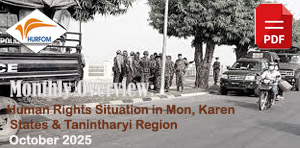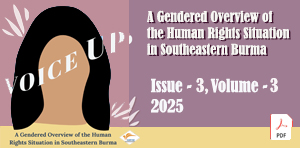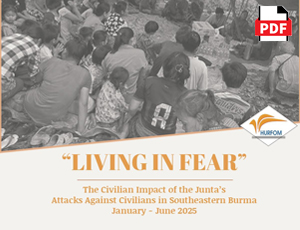Waiting in Tears: Impacts of impending cement factory development in Kyaikmayaw Township
October 20, 2010
Local communities in Kyaikmayaw Township, Mon State are facing the immanent threat of land seizer by local authorities, for the construction of a large scale cement factory and processing plant for the limestone from a nearby mountain. Nearly 600 acres of paddy land have already been surveyed for construction. The community, which is heavily dependent on the surrounding farmland passed on from generation to generation, has received no opportunity for input in the project, and only paltry warning of an impending “State” ordered seizer of its land. The project will have severe environmental impacts as it calls for the leveling of Ni Don mountain, the construction of a processing plant and factory, and construction of secondary infrastructure such as roads and a jetty into the nearby river. The company spearheading the cement plant construction is predominantly controlled by key members of the regime-backed political party the Union Solidarity and Development Party (USDP). Profits form the completed cement factory will be used to finance the government-backed USDP. In addition, the mountain is home to significant sacred Buddhist sites, relics, and cave paintings and drawings, which will be lost as the mountain is destroyed.
Eye-witness paddy fields owners, retired government staff who have been involved in key project development in the area, 12 monks and other local civilians who are familiar with the ongoing process, have been interviewed to provide the material for this short report. As the project has yet to begin, security in the region has increased significantly, therefore, for the sake of individuals’ security HURFOM has omitted personal information. For further information regarding individual cases and interviews, please contact HURFOM directly.
Farms to Factory
On October 6th, 2010, a 6 member team, including a township-level officer of the Land-Surveying Department of Kyaikmayaw Township, representatives from a cement-production company, Hexa International Company LLC. and local township authorities, arrived Ni Don village. Approximately 50 paddy field owners, who had been gathered together in advance by the village headman, were informed by the team that the “State” needed the land for cement production. According to farms at the meeting, they have until the end of the harvest season before government forces move to seize their land, approximately 2 months.

Nai San (not real name), 57, is an owner of a 5-acre parcel of land included in a land-survey conducted by the Kyaikmayaw Land Survey Department for the cement factory’s construction:
We have heard the bad news for a long time that the government authorities will produce the cement from raw-materials using limestone from [the] Ni Don Mountain. I said ‘for a long time’ because [we had first heard a rumor] five years ago. Now the bad news is 90 percent sure… They introduced themselves by saying their positions and where they come from, but not their names. And then [they said] the State needs raw-materials to fulfill its cement needs. The cement raw-materials will be produced from Ni Don Mount nearby our village, as they need. Therefore, (they) need our valuable freehold. land which is now cultivated with paddy. They didn’t mention they will “confiscate” or “buy” or “compensate” [us for the land]. Therefore, the farmers like us who depend on annual-paddy-production of these freehold[1] paddy fields have been worrying a lot. We can’t eat and sleep. No one can [advise] how to stop this process. The village abbot has been feeling grievous a lot dealing with this case. We are really worrying about this. We don’t know how to manage.
Impact
According to a project report that HURFOM has received, plants at Ni Don, at Pyar Mount nearby Kaw Panout village, and at Kawkalot Mount nearby Kawkalot village, are all planned by the Hexa Corporation to increase cement production, which has been in increasing demand. According to the report’s figures, Burma needs nearly 3 million tons of cement yearly, but the current production level is less than 1 million tons. The Pyandone project is only slightly bigger then the Ni Don project, and is expected to produce around 146,000 tons a year tons of concrete a year.
 The Ni Don project will consist of several central buildings that will be used in processing the raw limestone ore into cement. Analysis that was conducted by the State Peace and Development Council’s (SPDC) Land Survey Department for the project indicates that the project will eventually process all of Ni Don mountain, located only 2 miles from Ni Don village, due to its large volume of limestone and a chemical composition favorable for producing concrete.
The Ni Don project will consist of several central buildings that will be used in processing the raw limestone ore into cement. Analysis that was conducted by the State Peace and Development Council’s (SPDC) Land Survey Department for the project indicates that the project will eventually process all of Ni Don mountain, located only 2 miles from Ni Don village, due to its large volume of limestone and a chemical composition favorable for producing concrete.
A Mon man, 30, who graduated from university in with a degree in Geology and who used to serve in a field study for the Ministry of Mining, describes his point of view on the current Ni Don project from his experience working in research:
If you calculate according to the height and area, the amount of limestone-raw-material [in Ni Don Mountain] for cement [production] is about over 200 million tons. The geology department has measured [the limestone amount] in the past. As I know, they had already made laboratory experiment for cement production. They mainly measured the amount of Calcium Oxide (CaO), Magnesium Oxide (MgO) and Silicon Oxide (SiO2) the limestone. They came and measured four times. As I studied, the Ni Don Mount where the project is planned to operate, is a real limestone-mountain. I often encountered that the locals made lime by heating limestone when they want. If the project really starts, land-confiscation is sure to occur. In the case of Pyar Taung Cement Factory in Kaw Panout village, they openly confiscated the land without giving any compensation to the locals, but no one can complain. The State government confiscated (the land), so to whom do we go for trial?
The construction and operation of the cement factory, as well as the destruction and processing of Ni Don Mountain, will have extremely high environmental impacts on the area. Besides the construction impacts significant amounts of pollutants will be produced by the completed factory in the form of carbon dioxide (CO2); poisonous heavy metals in the air that are known to cause neurological problems and cancer; and heavy metal contaminants that will seep into the river, irrigation and drinking water. Additional high impact infrastructure will also eventually be required including roads; the construction of a jetty into the river, disrupting water flow; and the construction of a gas line to power the plant.
Dirty Money

The project report detailing the construction project, its investors, and project goal, lists the USDP as the primary investor in the company. Hexa International, which is spearheading the series of cement factory construction projects, is primarily owned by key members of the USDP. When the project was fist devised, the Burmese government’s civilian front group, the Union Solidarity and Development Association (USDA) was the primary benefactor, but as all USDA funding and property was transferred to the USDP despite apparent violation of election law. U Tun Way (not real name), Kyaikmayaw Town, Mon State, is a former government servant and has first hand knowledge of the land survey department. Based on his extensive knowledge about the current cement production project, he commented to HURFOM about the financial connection of the USDP to the project:
The land confiscation case due to [the need for] cement raw-materials is directly related to the USDP which is formerly known as the USDA. I want to mention they are directly responsible for [this case]. To establish this project, the Mon State USDA has negotiated with Hexa Company Limited which is based in Rangoon and has had a good relationship with the government for a long time. Since 2006, when I was a government staff, as my duty, I attended the meetings related to this case with them. The main point is that they held negotiating-meetings many times to negotiate [the profits of] the prominent businessmen like Hexa Company Limited but to secretly use most of the profits as USDP fund. Every meeting was directly managed by Nay Pyi Daw…I say this according to my experience of what I saw with my own eyes that about over 500 acres of valuable paddy fields and plantation owned by nearby Kaw Panout’s cultivators were confiscated for the Pyar Taung cement raw-material factory in Kyaikmayaw between 2006 and 2008. I saw with my own eyes that our Mon cultivators gritted their teeth in tears because their freely held family heritage land was confiscated. Now I feel awfully for the Ni Don farmers. It is sure that [their land] will be confiscated as soon as cement-raw-material production starts.
Maung Thet Paing who lives in Htone Pho Ward, Kyaikmayaw Town, and whose parents are Ni Don residents described how he sees the impending land seizer and construction as part of a larger political problem:
If the government were free, they [would] have authorities who [would] do [their project] only after getting the agreement of the local civilians and compensating [the local civilians] for the land many times more than the current value. The military government knows nothing about this. Over two years ago, their Hexa Company Limited – the company in which the USDA invests its shares – constructed a cement raw-material limestone-producing factory after confiscating over 500 acres of paddy fields, plantations and the land which belonged to the farmers nearby Kaw Panout village and its surrounding area. I have never heard that they gave any compensation for the land. No one dared to complain of the land-confiscation by them. There is no news in the media. Because of being a dictatorship, they confiscated the land and they didn’t care about anyone. Now (they) will confiscate (the land) nearby the Ni Don Mountain. I think they will follow exactly as [they did] in the past.
Essential for Life
According to local residents, the impending seizer of farmland in their community will be devastating to families and their livelihoods. For community farmers who are dependent on crop cultivation, the loss of their land will mean the loss of their livelihood and the likely breakup of close family and cultural ties. Moreover, the construction and operation of the Ni Don Cement factory will offer no opportunity for either sustained job creation or longer-term development of the local economy. Due to the local skill in farming and lack of technical training of most locals, the only possibility for work that will be created will be through hard labor during the construction and blasting processes.
Ni Don is home to an estimated 800 house holds, and over 80% of the population is dependent on farming for their livelihoods. All of the farms have been passed on through generations, and are the product of years of investment and cultivation. While it is not year clear if farmer will receive compensation for their crops, looking at the Pyar Taung project – the first of the three planned cement plants – all farmers who lost land due to construction received no compensation. Many farmers have reported that the loss of their land will be the loss of their only source of income and they will be forced to flee.
Nai Kon Hla, 50, a paddy farmer from Ni Don, describes the impact the threat of land seizer is having on him and his family:
I have 10 acres of paddy fields in total. In my surroundings, only my relatives [are] situated. In combination, the paddy fields of me and my relatives are at least about 200 acres. All are on the list of confiscation. According to them [visiting government and company representatives], it is in the area of land needed for the forthcoming project. My paddy fields are on the list and if they confiscate the land, my life is sure to fall apart. Unlike others, I have no property, but two pairs of cattle, an old house and 10 acres of paddy fields given [to me] by my father before his death. I depend on completely on this property. Now [that my paddy field] is on the confiscation list, my wife is crying every day. My children can’t be happy as usual. I don’t know what to do after confiscation. I can’t do any trading like others. We have been cultivating [paddy] since the period of my father and grandfather. I guess that [my fields] are valued at at least about 10 million [kyat].
Maung Thet Paing who lives in Htone Pho Ward, Kyaikmayaw Town, and whose parents are Ni Don residents explained how family land is essential for the local cultivators:
The 600 acres of paddy fields in our Ni Don village that they surveyed to confiscate are the best paddy fields in our village. It is rich soil and even if any kind of paddy is cultivated, the output is good. The paddy fields owners have been keeping their land with reverence because the fields are the heritage of their past generations. They have been working on traditional cultivation as their main living.…Now, if the government and Hexa Company Limited will confiscate this sort of land for cement factory construction, the farmers in the village will suffer like they hit rock bottom. According to the conditions, [the paddy fields] will be confiscated as soon as the paddy is harvested. My friend, a land-surveying clerk, said like this. I have a great attachment with the paddy fields because they are our freehold land. I feel unhappy. I can hardly believe that our traditional cultivation will be destroyed because of cement factory construction which is due to [the existence of] Ni Don Mount.
Loss of Culture
The Ni Don Cement factory project requires dynamiting Ni Don Mountain before it can be processed as concrete. However the mountain is home to a series of Buddhist cave temples with numerous items of Buddhist and Mon history. These objects include pagodas, temples, clay votive tablets, ancient paintings and ink inscriptions on the inside walls of the limestone-caves, and antiques. Due to Buddhist tradition, these artifacts, which date back to before local recorded history, cannot be removed as they were already donated. A 29-year-old monk in Ni Don village, Kyaikmayaw Township, who has been monk for 15 years and teaches Buddhist literature, described the value of the artifacts and the impact of their loss:
Looking only at their own benefits, the government will confiscate the civilians’ land. Moreover, they are trying to destroy the Buddha images in the cave of the Ni Don Mount, the pagodas and temples which were built by the past generations and is antique heritage. If [this heritage] is destroyed, the non-substitutable things of our Mon people, which are in the natural limestone-cave of the Ni Don Mount, which they will [use] to produce cement, will be lost. We have to feel inconsolable for the whole [of our] lives. In the inside of the cave of Ni Don Mountain, there are pagodas, clay tablets, votive tablets and Mon traditional painting. Moreover, there is a cave locally called “the plate-cave” in which there are antique plates, bowls, ladles and other man-made materials from an unknown period which were donated by the ancient people. All [of this] will be destroyed if the stone mountain is exploded with dynamite in order to produce cement. I think they do not consider about this. I grieve and worry a lot. I can do nothing but pray that [the project] will not really occur.
Resistance
While the Ni Don project is in its infancy, HURFOM research has so far indicated that this project is developed off of locally based and USDP investment, and SPDC regime support. While construction has not yet begun, it appears that the best opportunity for changing the current project will lie with local residents and community leaders. One such example was described by Nai Kon Hla, who proposes a letter writing campaign with the assistance of local leaders from the monastic community:
I imagine that we [could] all write an appealing letter to the particular authorities, but in our community, there is no one who can lead this activity and make it successful. I will discuss [this] with the village abbot again to do, as my idea. If the land was confiscated, I have no alternative but to go to Thailand for random hard labor.
Conclusion
The creation of large cement processing plants is overwhelmingly destructive for local communities and will never be a potential source of jobs for the communities that are disrupted. Residents are completely cut out of the decision-making process regarding the project’s development, denying them the opportunity to shape the impact of the facility on their community, or the opportunity to save significant local cultural artifacts and structures.
The victims of the immanent land seizer face a complete loss of livelihood through the seizer of farmland worth hundreds of millions of kyat after generations of investment and cultivation. The expected course of the factory construction and operation will at no point offer real jobs or economic development that is destroyed through the loss of farmland. In addition, the environmental impacts of this project will likely have significant knock on effects on the community, environment, and subsequently the surviving local economy.
Additionally the USDP, which is set to be the dominant party in the coming election, will play a significant role in the formation of the new government. But with a clear hand in the current development of the Ni Don and other cement factories, the USDP bears a significant amount of responsibility in the impending seizer of land and future construction. This current willingness to lead projects that undermine and destroy local communities strongly indicates that such practices will continue even after formation of a new government.
However, the intentions of local residents, like those of Nai Kon Hla, are one way in which community members could be active in attempting to improve the current situation. This and other locally based initiatives should be seen as a space in which local communities can be effectively supported to resolve such conflicts by their own effort.
![]()
[1] In this case freehold most closely translated from Burmese, refers to land that has been passed on for generations, and so no title or document exists to clarify ownership. The 2008 constitution states that all land is automatically owned by the state.
[SURVEYS 2]
Comments
Got something to say?
You must be logged in to post a comment.





















































